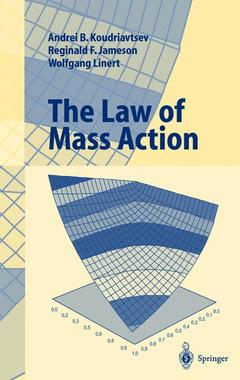1 Maxwell — Boltzmann Statitics.- 1.1 Thermodynamics and probab ility. The Boltzmann — Planck theorem.- 1.1.1 The Boltzmann — Planck theorem 5.- 1.2 The Maxwell — Boltzmann distribution law.- 1.2.1 Contin uous Maxwell — Boltzmann distribution.- 1.3 Calculation of most probable and mean values.- 1.4 Indistinguishable molecules. The Gibbs’ paradox.- 1.5 Phase volume and the number of quantum states.- 1.6 Quantum statistics.- 1.6.1 Bose — Einstein statistics.- 1.6.2 Ferm i — Dirac statistics.- 1.6.3 Comparison of the three types of statis tics.- 1.6.4 Degenera te ideal gas.- 1.6.5 App lications of Bose — Einstein statistics: black-body radiation.- 1.6.6 Applications of Bose — Einstein statistics: heat capacity of solids.- 2 Ensembles, Partition Functions, and Thermodynamic Functions.- 2.1 Gibbs— approach, or how to avoid molecular interactions.- 2.2 The process of equilibration and increasing entropy.- 2.3 Microcanonical distribution.- 2.4. Canonical distribution.- 2.5 The probability of a macrostate.- 2.6 Thermodynamic functions derived from a canonical distribution.- 2.7 Some molecular partition functions.- 2.7.1 Degeneracy.- 2.7.2 Translational motion.- 2.7.3 Free rotation.- 2.7.4 Vibrational motion: linear harmonic oscillator.- 2.7.5 Total parti tion function of an ideal system.- 2.8 Fluctuations.- 2.9 Conclusions.- 3 The Law of Mass Action for Ideal Systems.- 3.1 The law of mass action, its origin and formal thermodynamic derivation.- 3.2 Statistical formulae for free energy.- 3.3 Statis tical formul ae for ideal sys tems.- 3.4 The law of mass action for ideal gases.- 3.4.1 Conversion to molar concent rations.- 3.4.2 Conversion to mole fractions.- 3.4.3 Standard sta tes and standard free energies of reaction.- 3.5 The law of mass act ion for an ideal crys tal. Spin crossover equilibria.- 3.6 Liquids.- 3.6.1 The law of mass action for an ‘ideal liquid’.- 3.7 ‘Breakdown’ of the law of mass action.- 3.8 Conclusions.- 4 Reactions in Imperfect Condensed Systems. Free Volume.- 4.1 Additive volume: a semi-empirical model of repulsive interactions.- 4.1.1 Binary equilibrium in a liquid with repul sive interactions.- 4.1.1 Non-isomolar equilibrium in a liquid with repulsive interactions.- 4.2. Lattice theories of the liquid state.- 4.3 The Lennard-Jones and Devonshir e model.- 4.4 Chemica l equi libria in Lennard-Jones and Devon shire liquids.- 4.5 The non-id eal law of mass action, activities, and standard states.- 4.6 Kinetic law of mass action.- 4.7 Conclusions.- 5 Molecular Interactions.- 5.1 Introduction.- 5.2 Empirical binary potentials.- 5.3 Taking into account nearest, next nearest, and longer range interactions in the conde nsed phase.- 5.4 Frequency of vibrations.- 5.5 The shape of the potential wcll in a cell.- 5.6 Free volume of a Lennard-Jones and Devons hire liquid.- 5.7 Experimental determ ination of parameters of the Lennard-Jones potential.- 5.7.1 Compressibility: thc Born’ Lande method.- 5.7.2 Acoustical meas urements: the B.B. Kudryavtsev method.- 5.7.3 Viscosity of gases: the Rayleigh’ Chapman method.- 5.8 Conclusions.- 6 Imperfect Gases..- 6.1 Introduction. The Virial Theorem.- 6.2 The Rayleigh equation.- 6.2.1 Virial coefficients: the Lennard-Jones method for the determination of the parameters of a binary potential.- 6.2.2 Free energy der ived from the Rayleigh equation of state.- 6.3 A gas with weak binary interactions: a statistical thermodynamics approach.- 6.4 Van der Waals equation of state.- 6.5 Chemical equilibria in imperfect gases.- 6.5.1 Isomolar equilibria in imperfect gases.- 6.5.2 A non-isomolar reaction in an imperfect gas.- 6.5.3 Separate conditions of ideal behaviour for attractive and repul sive molecular interactions.- 6.5.4 Associat ive equilibria in the gaseous phase.- 6.5.5 Mole cular interaction via a chemical reaction.- 6.6 Conclusions.- 7 Reactions in Imperferct Condensed Systems. Lattice Energy.- 7.1 Exchange energy 203.- 7.2 Non-ideality as a result of dependence of the partition function on the nature of the surroundings.- 7.3 Exchange free energy.- 7.4 Phase separations in binary mixtures.- 7.5 The law of mass action for an imperfect mixture in the condensed state.- 7.6 The regular solut ion model of steep spin crossover.- 7.7 Heat capacity changes in spin crossover.- 7.8 Negative exchange energy. Ordering . The Bragg — Williams approximation.- 7.9. Description of order ing taking into account triple interactions.- 7.10 Chemica l equilibrium in ordered systems. Two-step spin crossover.- 7.11 Diluted systems.- 7.12 Conclusions.- 8 Chemical Correlations.- 8.1 Studies of variations of chemical reactivity.- 8.1.1 Molecular parameters governing variations of chemical reactivity.- 8.1.2. Solvent effects.- 8.1.3. Kinetic studies.- 8.1.4. Multidimensionality of var iations. Reference reactions.- 8.2 Linear free energy relationship. Modification of reactants.- 8.3 Linear free energy relationship. Variation of solvent.- 8.4 Isoequilibrium and isokinetic relationships.- 8.4.1 Statistical-mechanical model of the IER in ideal systems.- 8.4.2 The IER in gas-phase reactions.- 8.4.3 lsokinetic relationships.- 8.4.4 Non-ideality as a source of an IER.- 8.4.5 lER and exchange energy.- 8.5 Conclusions.- 9 Concluding Remarks.- 10 Appendices.- 10.1 Lagrange equations and Hamilt on (canonical) equations.- 10.2 Phase space.- 10.2.1 The phase space of a harmonic oscillator.- 10.2.2 The phase space of an ideal gas.- 10.3 Derivation of the canonical distribution.- 10.4 Free volume assoc iated with vibrations.- 10.5 Rotational con tribution to the equilibrium constant of the ionisation of water.- 10.6 Forms of the law of mass action employing the function approximation of the factorial.- 10.7 Derivation of the van der Waals equation of state.- 10.8 Exchange energy.- 10.9 Activity coefficients derived from the non-ideality resulting from triple interactions.- 10.10 The law of mass action for a binary equilibrium in a sys tem with non- additive volume and lattice energy.- 10.11 Physico-chemical constants and units of energy.



